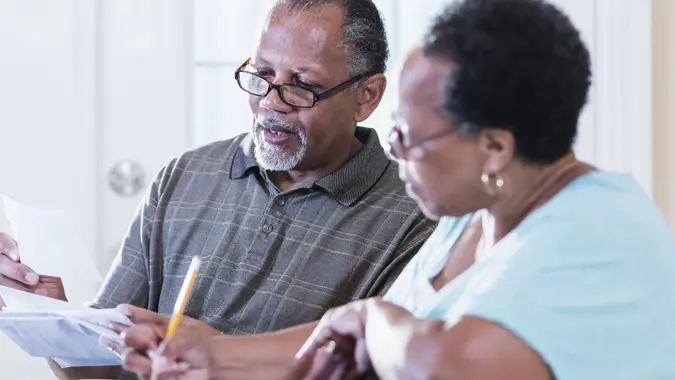Over 70% of Low-Income Women Have No Confidence in Their Ability To Plan for Retirement — 8 Solutions That Would Help Them

Commitment to Our Readers
GOBankingRates' editorial team is committed to bringing you unbiased reviews and information. We use data-driven methodologies to evaluate financial products and services - our reviews and ratings are not influenced by advertisers. You can read more about our editorial guidelines and our products and services review methodology.

20 Years
Helping You Live Richer

Reviewed
by Experts

Trusted by
Millions of Readers
Overwhelmingly, low-income women aren’t feeling good about their roadmap to retirement. A new survey from the National Council on Aging and the Women’s Institute for a Secure Retirement has found that over 70% of low-income women “say they are not confident about their ability to plan and save for retirement.”
In an email, Ramsey Alwin, NCOA’s president and CEO, told GOBankingRates that it’s “very difficult to save for retirement when you do not have access to a cost-effective way to do it.” She added that on their own, women, particularly low-income women, can “only do so much.”
“We prefer policy solutions, which will always help more people, and especially those without means, to things people can do individually,” she explained.
In the survey, women said they stand behind several possible Medicare and non-Medicare policy solutions. These are the eight that had the most support.
Potential Medicare Policy Solutions
Ninety-five percent of women said they want to see an expansion of Medicare coverage so that beneficiaries can get total care for chronic diseases. Alwin noted that obesity is an example of a chronic condition where Medicare “needs to step up.”
“The problem is that Medicare does not cover the full range of obesity treatments,” she wrote. “It covers intensive behavioral therapy only if delivered in a primary care setting and bariatric surgery, but it does not cover anti-obesity medications. It needs to start covering FDA-approved medications to diverse therapy options. We support the Treat and Reduce Obesity Act (TROA), which is a bipartisan bill designed to ensure coverage of anti-obesity medications under Part D.”
The majority of women (94%) also want to see Medicare and Medicaid updated so that older adults can get in-home care instead of ending up at nursing homes. Alwin stated that NCOA is a proponent of the HCBS Relief Act of 2023.
Another change women want to see? Ninety-four percent support an increase in assistance that enables low-income older adults to get Medicare benefits they qualify for but aren’t getting.
Alwin added that Medicare gives “modest funding for low-income beneficiary outreach and enrollment efforts, but since 2008, the funding has been extended with bipartisan support 12 times.” NCOA wants Congress to “make this program permanent, so that enrollment efforts can continue without the threat of disrupted funding.”
Finally, on the Medicare front, 94% of women said they’d like the program to incorporate health promotion and disease prevention programs that will help with more effective chronic pain management, decrease the risk of falls and lower social isolation.
“There are a lot of evidence-based programs that can help older adults improve or maintain their health, even when they have chronic conditions, but not all are covered by Medicare,” Alwin noted. “Covering something like chronic disease self-management programs that are offered, for instance, at senior centers instead of clinical settings would be more cost-effective and would help older adults live healthier lives.”
Potential Non-Medicare Solutions
As for non-medicare policy solutions, 96% of women who were surveyed supported giving a tax break to family caregivers. Caregiving drastically affects women financially, Alwin wrote.
“Many times, they need to quit their jobs, which affects not only their income, but their retirement savings as well,” she explained. “At the same time, the care infrastructure is insufficient. Medicaid does not cover much of the home- and community-based services, where someone would come to help with things like bathing, dressing, or walking. So many caregivers, themselves sometimes older adults, do not get much reprieve from their responsibilities.”
Additionally, 94% of women were in favor of refreshing the Supplemental Security Income program. Alwin stated that NCOA supports the bipartisan SSI Savings Penalty Elimination Act.
The majority of women (93%) also want lower-income adults to receive government help with necessities like food and housing.
“Right now, we have a patchwork of safety net programs for which people have to apply separately, which have different eligibility criteria, and which do not offer a solid support to all older who need it,” Alwin explained. “We need to simplify this and make enrollment easy or automatic, so all older adults can age with dignity and economic security.”
The last non-Medicare policy proposal concerned workforce shortages in elder care and disability care. Ninety-two percent of women said they want home care workers to get paid a minimum of $18 to $20 hourly and also get health insurance, retirement plans and other benefits. Alwin noted that NCOA supports the Long-Term Care Workforce Support Act and is taking additional action in this space.
“The shortage of direct care workers at a time when the population that will need these services is increasing is a slow-rolling crisis we need to address,” Alwin wrote. “Yes, low pay is part of why we have a shortage, but so is the fact that we have not made this a priority. NCOA was awarded a 5-year, $6.5 million grant from the Administration for Community Living (part of the Department of Health and Human Services) to establish the Direct Care Workforce Strategies Center to strengthen the care economy. This initiative will provide technical assistance to states and service providers to improve recruitment, retention, training and professional development of direct care workers.”
 Written by
Written by  Edited by
Edited by 

























